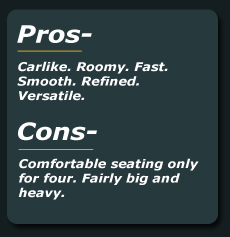2010 Honda Accord Crosstour
Prices: $29,670-$36,220
Honda bases its roomy, versatile new Accord Crosstour on its popular
Accord sedan. It thus adds a vehicle with a respected nameplate and
proven components to the hot crossover market and provides a strong
addition to its lineup.
Rivals include the Toyota Venza, Ford Edge and Nissan Murano
crossovers.
The Crosstour combines features of the Accord with the versatile
characteristics of a crossover, which is a combination car
and sport-utility vehicle. For one thing the Crosstour comes only as a
hatchback, while the Accord has a regular trunk.
As Honda puts it, it “starts with the top-level refinement of
the Accord V-6 sedan and further expands utility with a
sleek-yet-functional profile for increased cargo
space.” The Crosstour and Accord share
approximately 60 percent of their parts, including the powertrain,
chassis and instrument panel.
Larger and heavier than the Accord, the Crosstour is sportier than a
conventional crossover, although it’s designed more for
comfort and utility than sportiness. Some may feel its distinctive
styling looks sleek. Others may think it looks rather bulky, despite
its aerodynamic shape and sharply sloping roofline styled to conceal a
cargo area that can adapt to large objects that exceed the capacity of
a normal sedan.
In either case, darker colors work best with the Crosstour, which has
nicely chromed dual exhaust outlets.
The Crosstour is longer, wider and higher than the Accord sedan--and
several hundred pounds heavier, at 3,852 to 4,070 pounds. It also has
much more cargo space than the Accord, even without its rear seatbacks
folded forward. And its hatch provides easy access to the large cargo
area.
The Crosstour has standard front-wheel drive, but is available with
all-wheel drive, which isn’t offered for the front-drive-only
Accord.
Assembled in Ohio, the Crosstour comes as the front-drive EX and
higher-line EX-L, which is offered with front- or all-wheel drive.
List prices range from $29,670 for the base model to $36,220 for the
all-wheel-drive EX-L with a navigation system.
There really is no “entry” Crosstour. Even the EX
comes with many comfort, convenience and safety items. They include
dual-zone automatic climate control with second-row ventilation, power
moonroof, AM-FM 6-disc audio system with 7 speakers, tilt/telescopic
steering wheel, power front seats and cruise control.
There also are illuminated steering-wheel-mounted audio and cruise
controls and power door locks, windows and heated, folding side
mirrors--besides 17-inch alloy wheels.
The EX-L items include available all-wheel drive, leather-trimmed seats
with heated front seats, leather-wrapped steering wheel and shift knob,
“memory” driver’s seat, USB audio
interface and 18-inch alloy wheels with lower-profile tires for
slightly sharper handling.
Then there’s the EX-L’s available automatic Real
Time all-wheel-drive system that enhances all-weather and light-duty
off-road capabilities. It provides extra grip for rain, snow, dirt
roads and sandy conditions without the weight, fuel economy and
handling performance drawbacks of a conventional four-wheel-drive
system. Power is shot to the rear wheels only when
there’s insufficient traction for the front-wheel-drive
system.
The all-wheel-drive system is is available by itself or with a
satellite-linked navigation system.
Safety features for both trim levels include electronic stability
control, front-side and side- curtain air bags with a rollover sensor
and anti-lock brakes with electronic brake distribution and brake
assist.
While the Accord comes with a four-cylinder or V-6 engine, the
Crosstour only has a 271-horsepower V-6, which it shares with the
Accord. The engine can deactivate up to half of its cylinders when less
power is needed while cruising or decelerating.
Despite the Crosstour’s weight, the smooth, quiet engine
provides fast merging and 65-75 mph passing times. It’s
hooked to a crisp-shifting five-speed automatic transmission that
integrates a new downshift rev-match feature for smooth, sporty manual
downshifts.
There are no steering wheel shift paddles, but one can upshift or
downshift with the console-mounted transmission lever. The automatic is
programmed to suppress unwanted upshifts when cornering for better
control in curves.
Estimated fuel economy for the front-drive version is 18 mpg in the
city and 27 on highways. It’s 17 and 25 with all-wheel drive.
Only regular-grade fuel is needed.
Steering is firm and accurate. The ride is supple even over poor
pavement, and handling is quite good for such a heavy vehicle. A nicely
designed all-independent suspension helps out here, although the
Crosstour is designed more for ride comfort than tackling twisting
roads. The brake pedal has a progressive action that allows
consistently smooth stops.
Large outside door handles and wide-opening doorways help provide easy
entry, although it takes a little extra effort to get in and out of the
Crosstrour than in the Accord. Large outside mirrors help rear
visibility--a good thing because there is a split-window rear view.
The quiet interior is upscale, with easily read backlit gauges. Climate
controls are large, and sound system controls are fairly large. Front
console cupholders are conveniently placed and have a cover
when not in use. Front power windows can be easily stopped after their
automatic up-down feature is used. That’s virtually
impossible on some vehicles.
The front bucket seats are supportive when snaking through curves, but
the high, hard middle of the rear seat makes the Crosstour only
comfortable for four occupants. The middle of the rear seat is best
left to the fold-down armrest that has twin cupholders. However, there
is plenty of rear-seat room for long-legged rear occupants.
Cabin storage is decent with such items as front door pockets, although
rear door pockets are too small to be of much use.
Loading cargo is a breeze because the large hatch opening is low and
wide. Seatbacks sit flat when moved forward to increase cargo capacity.
The nicely shaped cargo area has a hidden, easily removable utility box
under the floor. There are reversible cargo area floor panels for dirty
objects.
There’s an impressive 25.7 cubic feet of cargo space with the
rear seats upright and a really impressive 51.3 cubic feet with the
seatbacks folded forward, not counting the 2.9 cubic foot box. The
Accord sedan has only 14 cubic feet of cargo space.
The hood glides open on twin struts and has an inside cover for noise
isolation, although the hatch only has a partial inside covering.
Finding the outside hood release is difficult unless you know
exactly where it’s located However, most fluid filler areas
can be easily reached.
The Accord Crosstour’s absence of a four-cylinder engine or a
marginally equipped base model shows that it’s aimed at a
generally older, more affluent crowd. But its added utility over a
sedan should be attractive to younger folks with the money for it.














